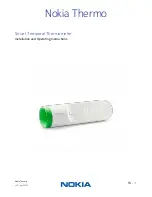
H86.0.04.6C-01
Operating Manual Gourmet Thermometer
Page 8 von 14
_____________________________________________________
_____________________________________________________________________________
6 Temperature probe
6.1 Probe accuracy/device accuracy
The device can be equipped with different interchangeable temperature probes. These are classified into the
following classes (EN 60751):
Class
Maximum deviation
Are of validity
B
± 0.3 °C at 0 °C ± 0.5 % of measured value
-
50 … 250 °C
A
± 0.15 °C ± 0.2 % of measured value
-
30 … 250 °C
AA (=1/3 DIN B)
± 0.1 °C ± 0.17 % of measured value
0 … 150 °C
To receive high exchange accuracy without necessity of additional adjustment (see chapter 8 Adjustment of
temperature input)
we recommend the usage of temperature probes from the class “A” or “AA”.
Do not touch the hot temperature sensor or cable during the cooking process or directly
thereafter with your bare hands. Always wear heat-resistant gloves.
6.1.1 Extra-thin insertion sensor
GF 2T Pt1000
– Precise, waterproof, extra-thin Class
B insertion sensor for quick measurements. Is
suitable for use in gases, liquids and soft plastic
materials. The stainless steel tube of the extra-thin
insertion sensor is designed for permanent contact
with food.
6.1.2 Durable insertion sensor
GF 3T Pt1000
– The Class B insertion sensor is
suitable for use in gases, liquids and soft plastic
materials. The stainless steel tube of the insertion
sensor is designed for permanent contact with foods
.
The 1-metre-long glass fibre insulated cable is
encased with a stainless steel braided jacket, heat-
resistant to 400 °C and equipped with a BNC plug
connector. Ideal for long-term measurements in
ovens or grills.
It can be cleaned with a damp cloth.
Water or moisture in the cable can cause produce faulty measurements. The error can be
corrected by drying the cable.
































